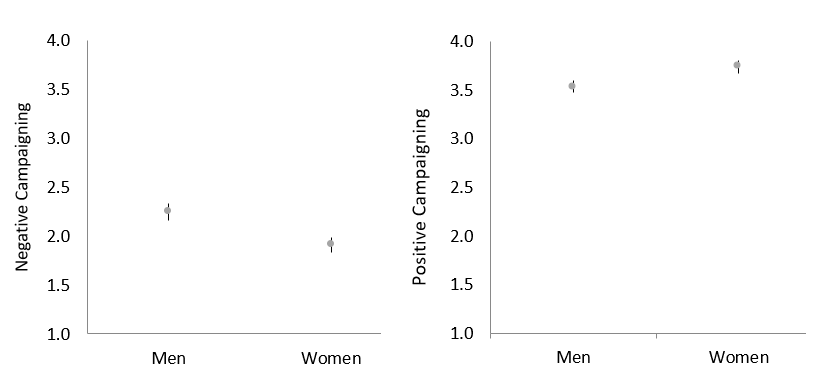Hilde Coffé is Professor in Politics at the University of Bath’s Department of Politics, Languages and International Studies. Theodora Helimäki is a Doctoral Researcher at the University of Helsinki. Åsa von Schoultz is Professor of Political Science at the University of Helsinki. This blog is based on their recent research article “How Gender Affects Negative and Positive Campaigning”, published in the Journal of Women, Politics & Policy (open access).
Campaigning is a central part of democracy: it can affect the outcome of elections and shape voters’ perceptions of political actors and the political system at large. While campaigning, politicians can use different strategies, including a positive or negative campaign strategy. Positive campaigning involves emphasising one’s own political visions and agenda whilst focusing on previous achievements or experiences and attributes that voters are believed to perceive positively. A negative campaign strategy is aimed at undermining the reputation of other candidates or parties by, for example, criticising their policy proposals, previous record, or personal attributes and experiences. While negative and positive campaigning can be clearly distinguished, they are not each other’s opposites. They are different strategies, and candidates may choose to use one or both.
In our study, we were interested in learning more about differences between women’s and men’s campaigning strategies. To date, most scholarly research has focused on negative campaigning and suggests that the extent to which candidates emphasise negative campaign messages is not gender-neutral. This literature is generally grounded in theories on gender roles which suggest, for example, more aggressive behaviour among men compared with women and more compassionate and gentle behaviour among women compared with men. This is translated into expectations of men campaigning more negatively than women. The general public is also more likely to accept negative campaign behaviour from men than from women. As such, women tend to be more likely to be punished electorally for using negative campaign messages, especially if they are the ones initiating the negative dispute, and tend to find it more challenging than men to convince voters that they are suitable for higher-ranking jobs. This may reinforce women’s tendency to focus on their own expertise and thus to campaign more positively than men.
To study gender differences in positive and negative campaigning, we relied on the 2019 Finnish Parliamentary Candidates Survey which asked candidates how strongly they emphasised positive and negative aspects in their campaigns. We thus measured candidates’ own perceptions about their campaigns. While subjective evaluations of personal behaviour should always be interpreted with some caution as answers may be subject to rationalisation, an introspective approach still provides valuable information regarding a candidate's behaviour.
By investigating the case of Finland, we study gendered ways of campaigning in a proportional representation system, an electoral context characterised by high gender equality and high levels of intraparty competition. Women's representation in the Finnish parliament has been comparatively high since the introduction of universal suffrage in 1906. In the 2019 election, 42 per cent of all running candidates and 47 per cent of all elected candidates were women. Given the relatively gender-equal representation in parliament and the high levels of gender equality in society overall, Finland offered a conservative test of gendered ways of campaigning, one in which gender differences may be less likely to occur compared with less gender-equal contexts. Yet, our analyses revealed distinct gender patterns in campaigning still occur.
As can be seen from Figure 1, women candidates report having campaigned more positively than men candidates, while men candidates are more likely to report having campaigned negatively than women candidates. In substantive terms, women have a predicted probability of 3.74 on positive campaigning compared with 3.54 for men. While a difference of .20 points on a scale from 1 to 5 is not huge, it is a statistically significant difference (as can also be seen in Figure 1). Men's predicted probability for negative campaigning is 2.25 compared with 1.91 for women. Women thus score .34 points lower on a scale from 1 to 5 compared with men, a more significant gender difference than for positive campaigning. While the gender differences are substantively not very significant, they show that overall, women and men campaign positively and negatively to a different extent.
Figure 1: Predicted probabilities (with 95% confidence intervals) for negative and positive campaigning among women and men
We also find that men are more inclined to incorporate a balanced mixture of positive and negative campaign messages, while women predominantly rely on positive campaigning.
What do we learn from these findings? Perhaps the main message is that campaigning is still gendered. Even in the Finnish electoral context, which is characterised by relative gender equality and high levels of intraparty competition, we find substantial gender differences in candidates' campaign strategies. Aligning with these findings are observations from the recently held Finnish parliamentary elections. There was a distinct tendency among men candidates from the populist radical right Finns Party – which was in opposition – to use negative campaigning messages. For example, Miko Bergbom, a young Finns Party candidate campaigning actively on TikTok, repeatedly posted videos with critical messages directed towards the left-wing government (led by a woman leader) and its policies. An example of a candidate with a distinctively positive campaigning strategy was Mari-Leena Talvitie, a long-time woman MP from the National Coalition (also in opposition) who presented herself as “builder for the future”, rather than focusing on criticising the performance and messages of other candidates and parties.
As gendered campaigning occurs in the Finnish context, characterised by high levels of intraparty competition and high levels of positive campaigning, as well as comparatively high levels of social and political gender equality, gendered campaigning is likely to also occur in other electoral and social contexts. This may particularly be the case in settings where competition revolves mostly between parties and not between candidates nominated by the same political party. Such systems offer a more fruitful ground for negative campaigning; a campaigning style which men candidates are on average more likely to use. Moreover, when comparing the gender differences in campaigning found in our study with those found by Carlson (2007) in his study on Finnish candidates' personal campaigning websites in the early 2000s, it appears that nearly 15 years of development towards a more gender-equal society, including a greater descriptive representation of women in politics, has had little impact on the campaign strategies women and men politicians apply. Gendered patterns of campaigning thus seem highly persistent.
Respond





